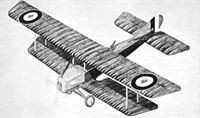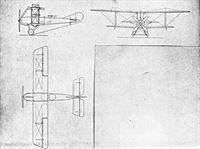P.London Saunders and Saro Aircraft Since 1917 (Putnam)
Saunders T.1
The decision to produce the T.1 arose through the personal desire of Sam Saunders to market his own aircraft designs and was a measure intended to offset the effects of boat-building contracts lost during the First World War.
The first all-Saunders design, the T.1 emerged in 1917, the product of a very small team under the leadership of H.H. Thomas, recently established at Cowes. The designation T.1 derived from the surname of its designer but the aircraft never received a name. The sole example was a two-seat land-based biplane.
The T.1 had single-bay unstaggered folding wings and with wire-braced extensions to the upper wingtips. Ailerons were fitted to the upper surfaces only. Construction was of wood with a fabric covering. The tail unit was of conventional design with single fin and rudder and monoplane tailplane.
The wooden fuselage of the T.1 had Consuta copper-sewn plywood covering with no metal fittings or bracing wires. Dual flight controls were installed and all engine instruments and controls were duplicated in the rear position. The observer in the rear cockpit had a Scarff-mounted Lewis gun and the pilot a fixed forward-firing synchronised Lewis. The precise intended role of the T.1 is difficult to define. The cutaways in the lower mainplane trailing edges perhaps indicate a reconnaissance role; dual instrumentation suggests a trainer, but armament disposition compounds the problem.
It was intended that the T.1 could be fitted with either conventional wheeled undercarriage or floats. There is no evidence to suggest that floats were ever fitted. Designed to be powered by a 200 hp Hispano-Suiza engine, the aircraft eventually flew with a 150 hp Sunbeam Nubian, Saunders being unable to obtain a Hispano Suiza because production of that engine was being diverted to S.E.5a airframes for Service use.
Despite the reduced power, the T.1 is said to have performed well in the air. It was test-flown from Somerton during 1917 by a Maj Evans, an RFC pilot. The only difficulty experienced by Evans was a tendency to engine overheating. Before long, the prominent straight-through 'smoke-stack' exhaust, perhaps so configured in the hope of achieving extra horse power, was discarded for a more conventional arrangement, an indication possibly that the Nubian was adequate after all.
H.H. Thomas died in the 1918-19 influenza epidemic and his T.1 design was not developed further. Suggestions by two former Saunders employees that it was planned to convert the T.1 for civil use have not been substantiated. It appears that some time late in 1918 the Nubian was removed, but the fate of the T.1 airframe is not known.
One 150 hp Sunbeam Nubian (No. 5530).
Span 37 ft 5 in upper, 24 ft 9 in lower; length 23 ft 8 in; height 11 ft 3 1/4 in; wing area 335 sq ft.
Empty weight 1,795 lb; loaded weight 2,680 lb.
Maximum speed 89 mph; cruising speed 74 mph; ceiling 11,100 ft; fuel 35 gal; approximate endurance 3 hr.
Armament: one .303 in fixed forward-firing Lewis and one .303 in Scarff-mounted Lewis machine-guns.
One example, X14 built under licence No. 13.
NB: 'x' numbers were issued between 1917 and 1919 to private-venture aircraft which were, nonetheless, given Government authorisation through the Licence system. These aircraft were not financed by any official contract.
J.Bruce British Aeroplanes 1914-1918 (Putnam)
Saunders T.1
THE boat-building firm of S. E. Saunders Ltd. became associated with the aircraft industry in its earliest days, for Saunders-built hulls were fitted to several of the first British flying boats. After the outbreak of war the company undertook the manufacture of several standard types of aircraft, including the Avro 504, Short 184 and Norman Thompson N.T.2B, and also built some flying-boat hulls for Commander Porte’s experiments at Felixstowe.
It was not until 1917 that the first all-Saunders aeroplane appeared. It was a two-seat tractor biplane designed by H. H. Thomas, from whose surname its designation of T.1 was derived.
The Saunders T.1 was intended to have either a wheel or float undercarriage, but it is doubtful whether it was ever flown in the latter form. It was of uninspiring appearance, and was a simple single-bay biplane with wire-braced extensions on the upper wings; ailerons were fitted to the upper mainplanes only. The structure of the wings and tail unit was conventional, with fabric covering on a wooden structure; but the fuselage was built of Saunders’ patent “Consuta” copper-sewn plywood, and contained neither metal fittings nor bracing wires. Full dual control was fitted, and all engine controls and instruments were duplicated in the rear cockpit.
The aircraft was designed to have the 200 h.p. Hispano-Suiza engine. At the time of its appearance, however, all engines of that type were wanted for S.E.5a’s, and none could be spared for installation in the Saunders biplane. A 150 h.p. Sunbeam Nubian was fitted, and with it the Saunders T.1 was test-flown from Cowes aerodrome by a Major Evans, an R.F.C. pilot who had seen service in France. The machine is said to have performed well despite its reduced power, and the only serious difficulty experienced during the trials was a tendency for the engine to overheat and boil the cooling water. Unfortunately H. H. Thomas died in the influenza epidemic of 1918, and the design was not developed.
SPECIFICATION
Manufacturers: S. E. Saunders Ltd., Cowes, Isle of Wight.
Power: 150 h.p. Sunbeam Nubian, engine No. 5530.
Dimensions: Span: upper 37 ft 5 in., lower 24 ft 9 in. Chord: upper and lower, 5 ft 6 in. Gap: 5 ft 6 in. Stagger: nil. Dihedral: 2° 30'. Incidence: 2° 15'. Span of tail: 14 ft.
Areas: Wings: 314 sq ft. Ailerons: 21 sq ft. Tailplane: 33-5 sq ft. Elevators: 22 sq ft. Fin: 5-5 sq ft. Rudder: 8 sq ft.
Tankage: Petrol: main tank 35 gallons.
Armament: The observer had a Lewis machine-gun on a Scarff ring-mounting, and there was a gun for the pilot: official diagrams show a fixed Lewis gun, synchronised to fire forward through the airscrew.
Serial Number: X. 14, built under Licence No. 13.
H.King Armament of British Aircraft (Putnam)
Saunders
T.1. No photograph exists of this two-seater of 1917, but a makers' sketch suggests a fixed Lewis gun for the pilot, mounted above the decking, and a rear Lewis gun on a pillar mounting.





